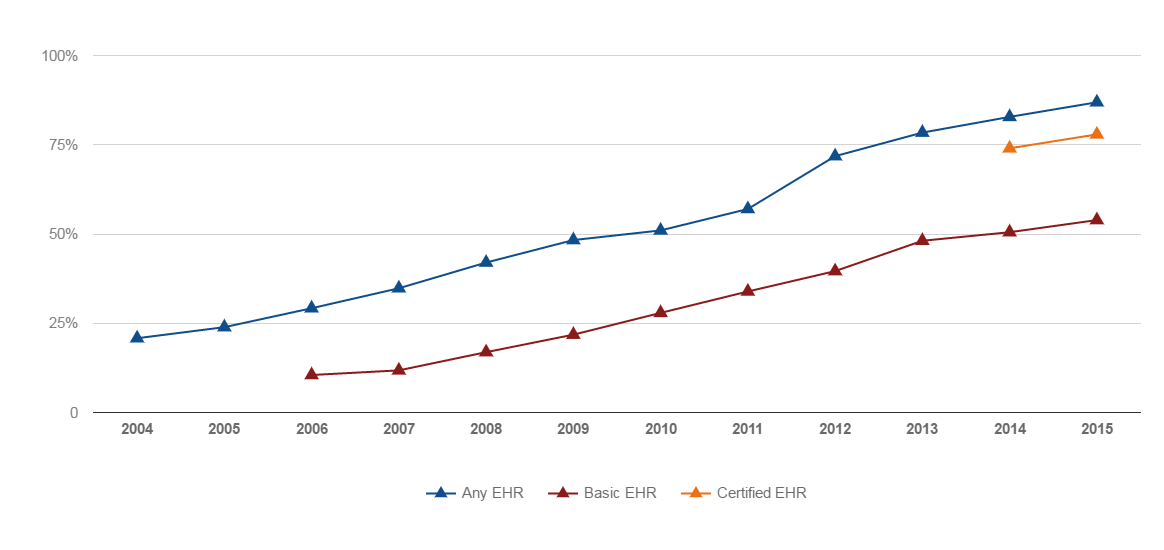Healthit.gov / Health IT Dashboard / Quick-Stats / Office-based Physician Electronic Health Record Adoption
This visualization may require more screen width to render optimally. Flip your mobile device to landscape to get an enhanced view of the visual below, or touch to scroll the image. To get the best view, try out this page on a tablet or desktop computer. Use the share icon in the menu to check out this page later.

Percentage of Office-based Physicians with Electronic Health Record System
2004 - 2015
| 2004 | 2005 | 2006 | 2007 | 2008 | 2009 | 2010 | 2011 | 2012 | 2013 | 2014 | 2015 | |
| Any EHR | 20.8% | 23.9% | 29.2% | 34.8% | 42% | 48.3% | 51% | 57% | 71.8% | 78.4% | 82.8% | 86.9% |
| Basic EHR | -- | -- | 10.5% | 11.8% | 16.9% | 21.8% | 27.9% | 33.9% | 39.6% | 48.1% | 50.5% | 53.9% |
| Certified EHR | -- | -- | -- | -- | -- | -- | -- | -- | -- | -- | 74% | 77.9% |
As of 2015, nearly 9 in 10 (87%) of office-based physicians had adopted any EHR[2], over 3 in 4 (78%) had adopted a certified EHR, and over half (54%) adopted a 'Basic EHR'[1]. Since 2008, office-based physician adoption of any EHRs has more than doubled, from 42% to 87%, while adoption of Basic EHRs has more than tripled from 17% to 54%. Between 2014 and 2015, adoption of any EHR grew by 5% and Basic EHR adoption grew by 7%. ONC and the CDC began tracking adoption of certified EHRs by office-based physicians in 2014.
Jamoom E, Yang N. Table of Electronic Health Record Adoption and Use among Office-based Physicians in the U.S., by State: 2015 National Electronic Health Records Survey. 2016
Jamoom E, Yang N, Hing E. Percentage of office-based physicians using any electronic health records or electronic medical records, physicians that have a basic system, and physicians that have a certified system, by state: United States, 2014 (table). 2015.
Hsiao C-J, Hing E. Use and characteristics of electronic health record systems among office-based physician practices: United States, 2001–2013. NCHS data brief, no 143. Hyattsville, MD: National Center for Health Statistics. 2014.
[1] Physicians adopted a Basic EHR if they reported their practice performed all of the following computerized functions: patient demographics, patient problem lists, electronic lists of medications taken by patients, clinician notes, orders for medications, viewing laboratory results, and viewing imaging results. The core capabilities of a Basic EHR were defined by DesRoches, et al. in the 2008 manuscript.
[2] Any EHR system is a medical or health record system that is either all or partially electronic, and excludes systems solely for billing.
[3] Data include non-federal, office-based physicians, and exclude radiologists, anesthesiologists, and pathologists.
[4] A certified EHR system is one that meets the requirements adopted by the US Department of Health and Human Services.
Office of the National Coordinator for Health Information Technology. 'Office-based Physician Electronic Health Record Adoption,' Health IT Quick-Stat #50. dashboard.healthit.gov/quickstats/pages/physician-ehr-adoption-trends.php. December 2016.